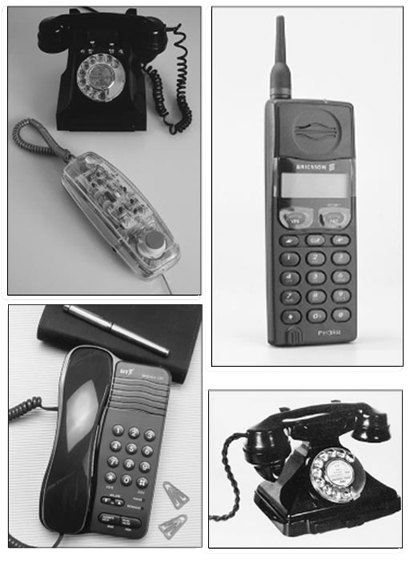1.2 Problems and solutions
One way to look at design is to consider it as a problem-solving activity. For example, a person designing the interior of a house has to solve many problems such as how to make it functional in an appropriate way (you don't, presumably, want your bed next to the cooker), how to make it attractive, how to make it comfortable, and how to achieve all this on a given budget. The designer needs to ask: 'Whom am I designing for?' An interior for one client may be very different to one designed for another client. Also, an interior which is intended to enhance the saleability of a property may be very different to one aimed at the owner's personal preferences. The design team responsible for a new motor car also has complex problems to solve including achieving a broad market appeal as well as meeting the required performance. There are various modelling techniques which designers use to help them understand problems and generate solutions.
Generally design problems comprise several factors. Those factors that are concerned with how people use, understand or interact with designs could be called 'human factors'. Other factors might concern 'materials' or 'manufacture'. Each factor is really a group of related concerns which might be vital to the design or they might be marginal in their relevance. Designers need to establish the relative importance of these factors and generate proposals which seem to offer a suitable compromise.
Partly, designing is this process of seeking suitable compromise. This course examines the tools and procedures which can assist this difficult process. Seeking compromise can be hard enough in relatively simple design jobs such as planning and redecorating a bedroom. When the task concerns the design of a new building, aeroplane, car, or even modest consumer products such as an electric iron, then the process of seeking compromise calls for a wide range of skills, knowledge, abilities and sensitivities.
Design problems usually have many, many possible solutions. One of the main things you will learn in this course is that there is generally no simple formula for finding the best design solutions. This is what makes design exciting, challenging, and rewarding. Some people are very good at it and, almost magically, manage to find wonderful new solutions. In this part of the course you will be exposed to some of this magic, and you will be encouraged to tease out some of the systematic knowledge about designing, using an extensive set of illustrations and case studies.
There will be self-assessment questions to help you develop and test what you are learning. Sometimes they will be designed to make you think, rather than testing some specific point in the preceding text. There are no right or wrong answers to many of these questions, since they depend on how you look at things. There are indications of possible answers and solutions in these cases but your solutions may be very different. As you go through the material you should become more confident at answering them. So, try your hand at the following, rather challenging self-assessment questions.
SAQ 1
Look around the room you are in. Write down three or four of the objects you see. Do you think they were designed? Was any part not designed? You might also like to think about the following questions, but do not worry if you cannot answer them. What problems do you think the designer had to solve? Do you think the solutions are good? Do you think the materials used helped solve the problems? Is there any evidence of innovation?
Answer
Although I don't know what is in your particular room, I can help you answer the question by illustration.
First, looking at the question overall, any human-made object you choose must have been designed. It did not arrive in its form by accident. Furthermore, every part of it was designed, and is there for a reason. I shall now discuss some specific examples. You should have had similar thoughts for whatever examples you chose.
Let us take my coffee mug. The designer had to ensure that it could hold hot liquids without disintegrating, and without it being too hot to pick up. It also had to look attractive, and not be too expensive. There are probably several other things that I did not immediately think of. For example, it must be comfortable to hold even when full of liquid and therefore quite heavy.
Nevertheless, it is a fairly standard ceramic mug (no innovation, although it is decorated in an unusual way). It works very well. The material it is made of is strong enough to contain the weight of liquid. The mug has a handle, which enables me to pick it up without burning my fingers. The ceramic material is not a good conductor of heat, which helps prevent the handle getting too hot, at least during the normal length of time for which the mug contains a hot liquid. A drawback of this material is that it is brittle, and if I drop it, the mug will probably break. The mug has rounded edges and is not dangerous (although it might be if I dropped it).
As another example, consider my chairs. I have two in this room. The designers of the chairs had the problems of giving me something comfortable to sit on, something reasonably portable and mobile, and making it reasonably cheap. Both chairs are quite ordinary and I don't see any real sign of innovation.
One of the chairs is covered in a vinyl imitation leather material. Since it is very hot (I am writing this in June), this chair is not comfortable, and I do not use it. Instead I use a chair covered in a woven cloth material which I find much cooler and more comfortable. So the designer of the first chair failed to solve the problem of making the chair comfortable. The chair I am sitting on is made of tubular steel, and is quite light. So the designer of this chair solved the portability problem. This chair was also inexpensive, so its designer solved the cost problem. So, am I sitting on the perfectly designed chair? I'm afraid not. It's a little hard for me, so the designer did not get a perfect solution to the comfort problem. But it might suit someone else very well!
SAQ 2
Let us take a familiar object: a telephone. Mine has a handset plus a base unit with buttons for dialling (note that the term 'dialling' is a hangover from the days when the design featured a rotating dial; see Figure 1).
Using any telephone of your own as an example, write a list of those broad factors which you think the design team had to consider when they came up with the particular compromise which is your telephone.
Answer
The factors fall into broad groups. Each group will be likely to contain many sub-factors. You might have thought of the following.
Functionality. What features should the telephone offer?
Human factors. Usability by a wide range of people. Does it suit the physical sizes of various people (head, hands and fingers)? Is it understandable and clear how to operate it?
Costs. Can it be made at a cost which is acceptable in the market place? Can costs be reduced anywhere?
Materials. What materials are compatible with the expected life-span? What might the buyers want or need? What materials might assist the protection of the internal components? What materials are compatible with mass manufacture?
Image. What form might be attractive to the market? Does it suit the intended context (home or office etc.)?
Manufacture. Is it specified how the phone must be manufactured or is there flexibility to exploit new processes? How many telephones are to be made? Can assembly costs be reduced?
Marketing. Where and how will the telephone be sold (mail order, shops, Internet)?
Does packaging and marketing have an influence on product design?

